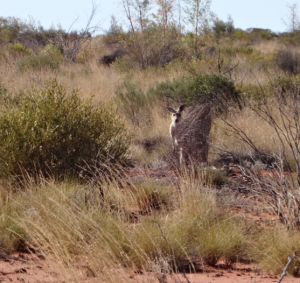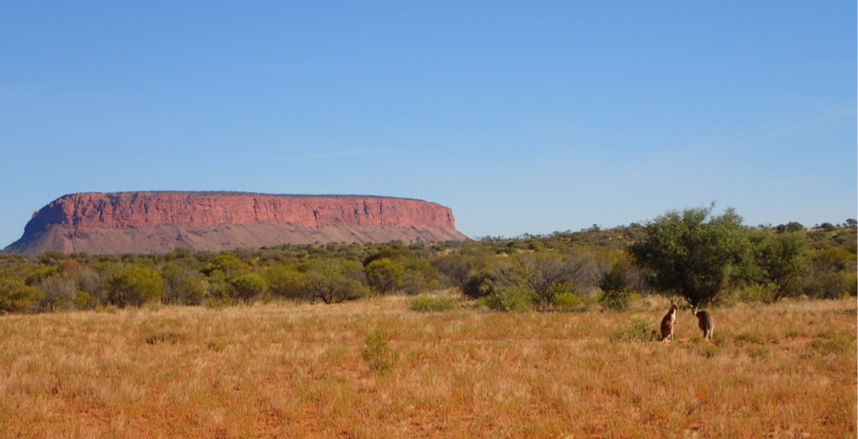Kangaroos in Central Australia – G’day, today I’d like to provide you with a bit of heads up for those driving to Uluru or on the highway to Kings Canyon and Alice Springs.
There is so much to see and do out here, and Australia isn’t always exactly what you expect it to be. Central Australia is made up of vast open spaces where plenty of wildlife live, if only you know what to look out for! Below you’ll find information all about red kangaroos, or Malu as the local Anangu people call them, and what to expect from them as you’re driving along.
The Expectation:
Tourists from everywhere around the world come to Central Australia with the expectation that there are kangaroos hopping around Uluru as you drive by, eating grass as you watch the sun set, posing in front of Uluru for that perfect Instagram photo but this is not the case.
Every now and again the odd Euro, or Rock Wallaby will be sitting quietly, snacking on grass in Walpa Gorge, or hiding amongst the trees and rocks at the base of Uluru. But the Red Kangaroo is less common than you probably realise.

Kangaroo Hiding amongst the bushes. Photo Credit: IG @walpagorge
The Reality:
Driving down the Lasseter highway as tour guides, whether it’s the middle of the day or later on into the night, our eyes are always sharp, looking across the land for any wildlife that may try to cross our paths.
However, not many people realise that the main target we look for are not kangaroos, but cows, camels, horses, reptiles, and the occasional bird that flies past.
Drive towards Melbourne airport, through new estates out the back of Sydney, pretty much anywhere through Canberra and you are likely to see kangaroos hopping around. Come to the middle of central Australia and you can consider yourself lucky to spot one.
Where are they?
You see, like most humans, kangaroos like to hang around a good food source. When that food source runs out they need to either to wait it out till the next rainfall or head to a new area. Back in 1956, there was a 9-year drought in the centre making it very hard to survive the harsh desert heat everyday.
About 4 years ago any time you turned off the main highway onto dirt road you could almost guarantee seeing a small mob of kangaroos. As the years have passed by however, the food has started to dry out and the kangaroos have headed for the shelter and abundance of food at the base of the mountains. Uluru and Kata Tjuta are surrounded by mountains way out in the distance. You have the Petermann Ranges out in the west, the Musgrave Ranges in the south and the George Gill Ranges out near Kings Canyon. The James Ranges and the McDonnell Ranges are located in the northeast of central Australia. The weather is drawn to these areas as they are higher points that the surrounding us making the vegetation greater around the mountains more substantial for the mammals.

Road Block: When you have to stop in the middle of the road to give way to the wildlife. Photo credit: IG @mon_a_tron
Wouldn’t this come in handy for us all.
Kangaroos are very good at reading the environment they inhabit.
You see, the female roo can have up to three babies on the go at once. A joey hopping around outside of the pouch, one in her pouch and an infant in the womb.
If the pouch is occupied the baby in the womb is put into a state of suspended animation better known as embryonic diapause. The mother has control and stops the growth of the baby putting it on hold until its sibling leaves the pouch.
This reproductive system is very helpful to the roos at it helps maintain their number through tough times and helps deal with the ups and downs of the harsh weather cycles of the desert.
Food. Everyone needs it.
Kangaroos are also a fantastic food source not only for the local Anangu people but for you too. The meat is very lean and full of protein.
The Anangu people use the whole animal as back in those days you couldn’t let things go to waste. First the animal was singed in the fire, removing all the hairs and then is eventually cooked in the coals. The tail and softer elements of the animal were often saved for the youngest and elders of the group. They are much more easy to eat when you don’t have many teeth. The rest was shared between everyone else. Once it was all gone the bones were used as tools and for spears.
If you head into the supermarket in Yulara and visit the freezer section, it is not uncommon to find roo tails for sale. They are also found in most community stores as well. Roo Tail is still a delicious treat cooked on the campfire while everyone sits around talking.
How do you spot the roos?
They are more of a challenge to spot than you realise. The red colouring of their back blends into the sand very well and the light brown fur on their chest disguises them among the long spinifex grass.
You might laugh but even the tour guides get excited when they spot a kangaroo on tour and race to get their cameras out before they go bouncing away from the vehicle.

Roo with a view: Depending on the rainfall, views like this can be quite an exciting sight to see.
Tours with a chance of seeing Kangaroos:
SEIT Tours have 2 very different tours where you can head out exploring some of this more unique environment with the chance of seeing the big red kangaroos.
These tours include the SEIT Mt Conner 4WD Outback Adventure and the SEIT Cave Hill day tour. These tours head off the beaten track deep into the desert close to some of the aforementioned mountain ranges.
More information about these tours can be found in the links above. Otherwise for a range of touring options around central Australia Feel free to browse our website.

